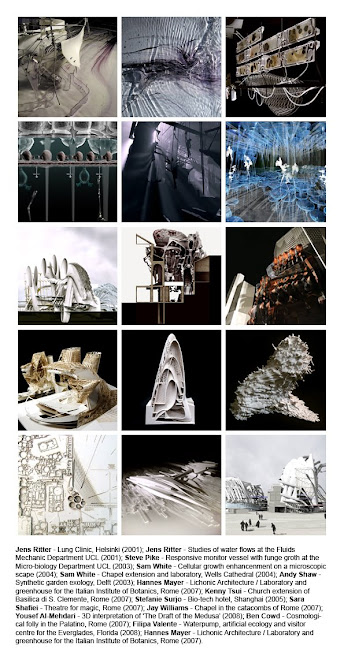Convoluted Flesh
The convoluted (i.e. overlapped, intertwined and blurred) nature of contemporary architectural design, as we understand it, goes beyond the functions of opulence and intricacy, of technique and simulation, of module and optimisation. It invokes something ranking above notions of beauty, style, and elegance - it evokes the sublime, the blissful and the mysterious.
Simultaneously, our understanding of Flesh in architecture stands in opposition to the common, yet reductive metaphor of skin as a flat and thin membrane. In a time when a lot of the mainstream architectural discourse is essentially surface-bound - risking flattening and disembodying the architectural ‘skin’ ever more, the aim of Convoluted flesh, on the contrary, is to stress the urgency of a Thick Embodied Flesh.
Our endeavour is then to establish a debate in which experimentation, technology and progress does neither exclude the intuitive and poetic freedom of designers as truly creative thinkers, nor the inherent relationship between the user and the depth of the architectural flesh. Hence, we consider a poetic, as well as ‘corpological’ approach that complement a typological, topological and ecological understanding of architecture. At the same time, we pursue an approach that develops from inside out, involving experiential qualities, inhabitation and use.
The research developed in Unit 20 spirals away from the apparently unquestioned and rather predictable version of what we observe as the contemporary emergence of a new ‘digital modernism’: the unspecified ‘whitewash’ of 3D surfaces, the universal Sachlichkeit (objectiveness) of parametric design techniques, and the mechanistic concept of the computer as a purely generative utensil. In turn, Unit 20 has formed a particular interest in the individual’s eccentric, yet informed understanding of architecture. By looking into technological advances within a wide range sciences and art, manufacturing technologies and interdisciplinary work methodologies, students are encouraged to develop a two-year individual research. Their work proposes a synthetic model of architecture that convolutes the ecological with the poetic, the visionary with the historic, as well as the ornamental with the tectonic.
Sublime ecologies, or ecologies of the sublime?
This year’s theme evolves around atmospheric interpretations of the sublime and environmental preoccupations of natural and urban ecologies. The field trip will crucially inform each individual project on both contextual and aesthetic levels. We aim to experience the sublime in and around the European Alps and discover a series of unique buildings and ecologies. These include BMW Welt (Coop Himmelb(l)au), Olympia Stadium (Frei Otto and Behnisch & Partner), Allianz Arena (Herzog & de Meuron), Schloss Neuschwanstein (Christian Jank for Ludwig II), Vitra Design Museum (Frank Gehry) and Firestation (Zaha Hadid), Landesgartenschau (Zaha Hadid), Goetheanum (Rudolf Steiner), Ronchamp chapel (Le Corbusier), La-Chaux de Fonds (early house of Le Corbusier), Firminy chapel (Le Corbusier), La Tourette (Le Corbusier), Matterhorn and Mont Blanc (mountains in the Swiss Alps), SS. Sindone (Francesco Borromini), Immacolata Concezione (Guarino Guarini), Teatro Regio (Carlo Mollino), old Fiat factory / Lingotto (Mattè Trucco / Renzo Piano), Palazzo del Lavoro (Pier Luigi Nervi), and Portovenere / Liguria...


+copy.jpg)




1 comment:
Nice post :)
design lovers, get inspired!
Check out this two new brands
Boca do Lobo and Delightfull. Hope you like it!
Post a Comment